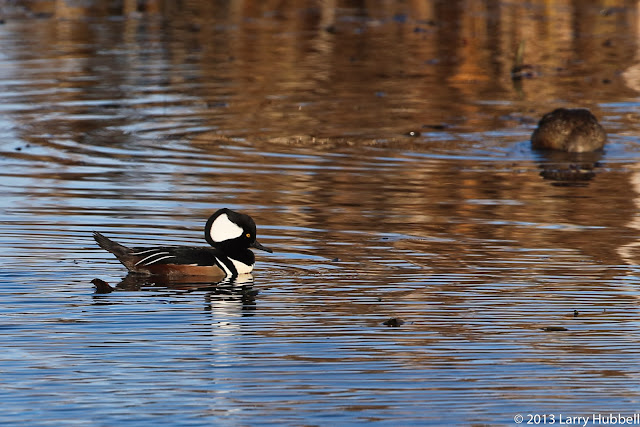On Thursday as the sun struggled to rise above Union Bay there was a pink tint in the sky and a purple hue reflected in the ice on Duck Bay. This week The Pirate from Kingfisher Cove has spent a lot time in these tall cottonwoods looking north towards open water and potential prey. Given that Kingfisher Cove and Duck Bay were mostly frozen over this was not a surprise.
Albert and Eva were also seen sitting in their favorite cottonwood tree on Foster Island.
They were also looking north, towards the Union Bay Natural Area, however their focus was undoubtably on the hundreds of birds seeming to form virtual rafts on Union Bay.
With the birds driven away from shore by the ice my attention turned to exploring new opportunities. Looking east from Foster Island, Eva and Albert's nest barely visible in the upper right, the frozen beaver canal through the wetlands looked inviting.
When ice-free the canal is too shallow for a kayak and way too muddy to explore by foot. In the winter there would not be any nesting birds to disturb, so why not take a look? What surprises were hidden there? I wondered if the ice would hold while crossing from Foster Island?
Slowly creeping out on to the ice I found myself looking carefully for cracks or other signs of weakness in the ice.
This formation of frozen bubbles made me wonder how they were formed?
Clearly there is a vertical relationship between the bubbles, but did they form at the same time or over multiple days as the top of the water thawed and refroze. But how could the water be solid enough to hold and freeze a lower bubble while still allowing some air to flow through to form the next shape on top? Are the bubbles connected so that air can flow from one to the next?
A little further on these spots appeared on top of the ice. What caused them? Could they be bubbles that actually burst through to the surface of the ice just at the moment the ice froze? Or perhaps they are from the impact of nearly frozen raindrops?
It was also interesting to note that the ice seemed to struggle to form around wood. Why it that? Is it that the wood retains heat better than water so even after days of freezing temperatures the ice does not completely encase the wood? Or is it because the wood moves as the water level changes there by releasing a bit of energy and breaking the bonds of the ice? If that is true then what about the ice at the end of this little log?
How did it form so clean and clear if it was constantly being broken and reformed?
What about this leaf ? It seems to have helped form multiple layers of impressions in the ice and yet it does not appear to be embedded in the ice. So was it just chance that it was resting here?
Having crossed over to the beaver canal the fear of breaking through the ice subsided.
A piece of wood gnawed clean and nearly cut in two provided evidence that the beaver had been working here during warmer weather.
These paw prints on the ice let me know some creature had passed this way after the ice had formed. My first thought was a raccoon had been out exploring the wetlands.
On the other hand these foot prints look like the hind feet of a beaver. Curious I would not have guessed the beaver would venture across the ice. I would have thought they might feel a bit like a fish out of water.
On the way back to Foster Island I noticed this turtle shell in the distance.
It made me wonder what was the story behind the shell? Was it empty and floating on the water when the ice formed and froze it in this location? or Did the turtle linger too long on a log near a slowly freezing pool of water?
Did you notice how the shadow from the shell allows one to peer below the surface of the ice? Sometimes it is the absence of (reflected) light that helps us see.
You may be wondering how all this relates to the title of this post. Walking across the ice reminded me a a piece of art work my Mother gave me many years ago. It said something like, If you have to walk on thin ice, you might as well be dancing!
This positive philosophy sounds great in theory but when actually crossing ice I didn't really feel like dancing, however I was happy to explore another side of nature.
Have a great day on Union Bay...where nature lives in the city!
Larry
PS: Here is one more interesting formation on the ice.


































































